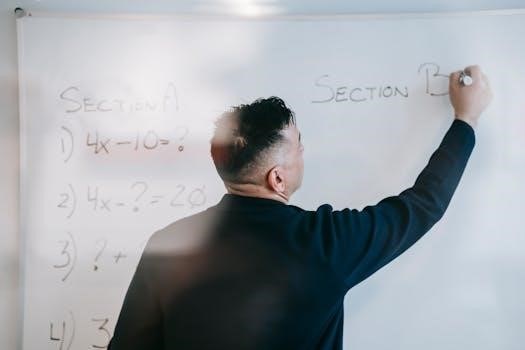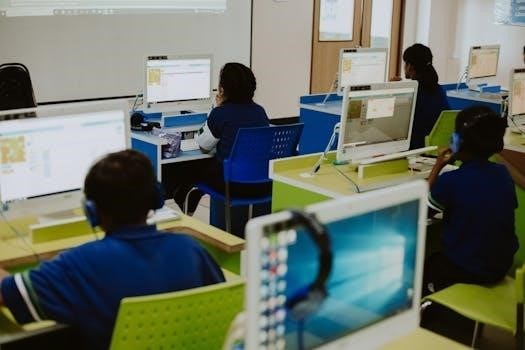Curriculum and instruction are fundamental to education. Ralph Tyler’s “Basic Principles” provides a framework for understanding their relationship. His work emphasizes a systematic approach, focusing on planned learning experiences and evaluation.
The Significance of Ralph Tyler’s Work
Ralph Tyler’s 1949 publication, “Basic Principles of Curriculum and Instruction,” is a cornerstone in the field. It moved curriculum from a static, subject-centered approach to a dynamic, purpose-driven one. Tyler’s work introduced the concept of evaluating curriculum plans with the same rigor as student assessments. His influence is evident in how educators now view curriculum development, emphasizing a cyclical process. Tyler provided a rationale for studying curriculum and instruction, not just a how-to guide, making his work a standard reference. His ideas continue to shape the field, providing a foundation for creating effective learning environments. His approach remains relevant even with the changes in educational standards. Tyler’s framework is still used in curriculum design and development today.
Core Principles of Curriculum Development
Curriculum development centers around key principles. These involve defining objectives, selecting experiences, organizing instruction, and evaluating progress. These steps ensure a structured and effective educational approach.
Defining Educational Objectives
Establishing clear educational objectives is the cornerstone of effective curriculum development. These objectives should articulate what students are expected to learn and achieve. Tyler’s framework emphasizes that objectives should be specific, measurable, achievable, relevant, and time-bound. They should guide the selection of learning experiences and evaluation methods. These goals should reflect the needs of students and the broader educational purposes. A well-defined objective ensures that the curriculum is purposeful and focused. The process involves careful consideration of the desired outcomes, aligning curriculum with standards, and ensuring all aspects of instruction contribute to these aims. These objectives drive the entire curriculum design process, ensuring a clear path for student success.
Selecting Appropriate Learning Experiences
Choosing the right learning experiences is crucial for effective curriculum implementation. These experiences should actively engage students and facilitate the achievement of educational objectives. Tyler emphasized that learning experiences must be aligned with the defined goals, providing opportunities for students to apply new knowledge and skills. Activities should be varied, catering to different learning styles and preferences. Selection must consider the content, the context, and the students’ prior learning. Furthermore, these experiences should be meaningful and relevant to the students’ lives. The ultimate goal is to create an environment where students are actively involved in their own learning process, leading to deep understanding and long-term retention.
Organizing Instruction Effectively
Effective organization of instruction is paramount for successful learning. This involves structuring learning experiences in a logical, coherent way to maximize comprehension and retention. Tyler’s principles emphasize the importance of sequencing content so that new knowledge builds upon prior learning. Instructional strategies should be chosen deliberately, aligning with both the learning objectives and the chosen learning experiences. Teachers must consider pacing, grouping, and the use of various resources to create a dynamic and engaging environment. Clear communication of expectations and learning paths is also vital. Proper organization ensures a smooth flow of learning, preventing confusion and encouraging active participation from all students.
Evaluating Curriculum Progress
Evaluating curriculum progress is an essential step in the educational process. It’s not enough to simply implement a curriculum; its effectiveness must be continuously assessed. Tyler emphasizes that evaluation should be systematic and data-driven, using a variety of methods to measure student learning outcomes. This process involves gathering evidence of student achievement in relation to the stated objectives. This data should then be analyzed to identify areas of strength and weakness within the curriculum, which can then inform future refinements. Evaluation isn’t just about student performance; it also assesses the effectiveness of instructional strategies and the overall design of the curriculum. Feedback from students, teachers, and other stakeholders is also valuable in this process.

Curriculum as a Dynamic Process
Curriculum development is not a static event but a dynamic, ongoing process. It requires continuous evaluation and refinement, adapting to evolving needs and new insights. This cyclical nature is key.
The Cyclical Nature of Curriculum Planning
Curriculum planning, as highlighted by Tyler, is not a linear progression but a cyclical process, demanding continuous attention and adjustment. This iterative approach starts with establishing clear educational objectives, followed by the selection of suitable learning experiences. Subsequently, these experiences are meticulously organized to facilitate effective instruction, and finally, the entire process is evaluated to measure progress and identify areas needing refinement. The insights gained from evaluation then inform the next cycle of planning, ensuring the curriculum remains relevant and effective. This constant cycle ensures that curriculum development is a responsive and adaptable process, meeting the ever-changing needs of students and the educational environment. This continuous loop of design, implementation, and evaluation ensures that the curriculum is always being improved.
Continuous Evaluation and Refinement
Tyler’s principles emphasize continuous evaluation as an essential component of curriculum development. This ongoing process involves systematically examining the effectiveness of the curriculum in achieving its stated objectives. Data gathered from various assessment methods, both formal and informal, are crucial for this stage. The insights gained from this evaluation are then used to refine the curriculum, identifying areas that need improvement, adjustment, or complete overhaul. This iterative process of evaluation and refinement is not a one-time event, but a continuous cycle that ensures the curriculum remains relevant, effective, and responsive to the changing needs of students and educational goals. This dedication to continuous improvement is what keeps a curriculum dynamic.

Relationship Between Curriculum and Instruction
Curriculum and instruction are intertwined. The curriculum acts as a guide, specifying what to teach. Instruction is how that curriculum is delivered, focusing on teaching methods.
Curriculum as a Guide for Instruction
The curriculum serves as a detailed roadmap for instruction, defining what content should be taught. It outlines learning objectives, subject matter, and activities, ensuring alignment with educational goals. This guide isn’t static; it needs constant review and fine-tuning. It is crucial for teachers to use the curriculum as a framework when planning lessons. This approach focuses the educational process. Using a curriculum as a guide provides a clear path for teachers to deliver effective instruction and for students to engage in meaningful learning. It also ensures that instruction is purposeful and aligned with the overall educational vision.
Instruction as the Implementation of Curriculum
Instruction embodies the practical application of the curriculum. It’s how teachers transform the written plan into tangible learning experiences for students. Effective instruction requires careful consideration of teaching methods, resources, and student engagement. It involves taking the goals and content defined in the curriculum and bringing them to life in the classroom. This process isn’t passive; it requires teachers to be adaptive and responsive. The implementation of the curriculum through instruction is a dynamic process that shapes how students achieve learning objectives. This is where theory meets practice.

Practical Application of Principles
Applying curriculum principles involves creating a vibrant learning environment and aligning curriculum with educational standards. This ensures that the curriculum is relevant, effective, and meets student needs.
Creating a Vibrant Learning Environment
A vibrant learning environment is crucial for effective instruction. It goes beyond physical space and encompasses the emotional and intellectual climate. It’s about fostering student engagement, encouraging active participation, and promoting curiosity. This environment is characterized by respectful interactions, collaborative opportunities, and a sense of belonging. Teachers should design learning experiences that are stimulating, relevant, and challenging. The goal is to create a space where students feel safe to take risks, express their ideas, and learn from their mistakes. It’s a place where learning is not just a passive reception of information, but an active, dynamic, and exciting process.
Aligning Curriculum with Standards
Aligning curriculum with standards is a critical step in ensuring educational quality. Standards provide a framework of learning goals and expectations for students at different grade levels. Curriculum should be deliberately designed to meet these standards, ensuring that students are learning what they need to know. This process involves reviewing the standards and determining how to integrate them into the curriculum. This alignment also includes selecting relevant materials, developing appropriate assessments, and planning instruction that addresses the standards’ requirements. The ultimate aim is to create a coherent and consistent learning experience that prepares students for future success.

Tyler’s Influence and Legacy
Tyler’s work remains a standard reference in curriculum development. His emphasis on planning and evaluation continues to influence educational practices, ensuring his relevance in contemporary education.
A Standard Reference in Curriculum Development
Ralph Tyler’s “Basic Principles of Curriculum and Instruction” has become a cornerstone in the field, widely regarded as a standard reference for educators and curriculum designers. Since its publication in 1949, it has consistently been used as a guide for understanding and developing educational programs. Its emphasis on systematic planning, clear objectives, and thoughtful evaluation has made it an invaluable resource. The book’s straightforward approach and actionable insights contribute to its enduring relevance, solidifying its place as a trusted companion in curriculum development. Educators across the nation use Tyler’s recommendations as they align their curriculum with standards and strive for effective instruction.
Relevance in Contemporary Education
Despite being published decades ago, Ralph Tyler’s principles remain highly relevant in contemporary education. His emphasis on aligning curriculum with clear objectives and evaluating progress is crucial in today’s educational landscape. The need for thoughtful curriculum planning and continuous refinement is as important now as it was in 1949. With the ever-evolving educational standards, Tyler’s framework provides a solid foundation for educators. His work also highlights the cyclical nature of curriculum development, emphasizing the need for ongoing evaluation and adjustments. This continuous improvement approach is vital for creating effective learning experiences for all students.
